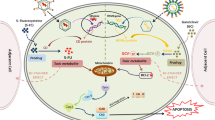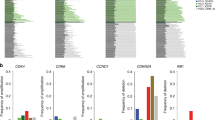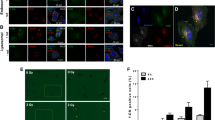Abstract
Malignant gliomas of astrocytic origin have commonly expressed several features such as alterations in the tumor-suppressor gene p53 or p16 or the acquisition of telomerase activity, which are distinctive from astrocytes. Therefore, restoration of the tumor-suppressor gene or telomerase inhibition is expected to provide a cure for malignant gliomas. We have recently demonstrated that the treatment with a 19-mer antisense oligonucleotide against human telomerase RNA linked to a 2′,5′-oligoadenylate (2-5A-anti-hTR) inhibited the growth of malignant glioma cells. From a therapeutic point of view, it is very important to investigate the antitumor efficacy of 2-5A-anti-hTR combined with the restoration of p53 or p16 gene. In this study, we evaluated the antitumor effect of 2-5A-anti-hTR in combination with recombinant adenoviruses bearing p53, its associated p21WAF1/CIP1, or p16CDKN2 gene (Ad5CMV-p53, Ad5CMV-p21, or Ad5CMV-p16) against malignant glioma cells in vitro and in vivo. Five malignant glioma cell lines expressing the mutant p53 gene (A172, GB-1, T98G, U251-MG and U373-MG) were more sensitive to the combination of 2-5A-anti-hTR and Ad5CMV-p53 than to other combinations. The additive effect of the combination therapy was due to induction of caspase-dependent apoptosis and cell growth arrest. Furthermore, the 2-5A-anti-hTR treatment when combined with Ad5CMV-p53 showed greater efficacy against subcutaneous U251-MG tumors in nude mice. In contrast, U87-MG cells expressing the wild-type p53 gene were insensitive to Ad5CMV-p53, although the treatment with 2-5A-anti-hTR was significantly effective. These results indicate that combining 2-5A-anti-hTR with Ad5CMV-p53 has the most therapeutic potential for malignant gliomas with mutant p53. For tumors exhibiting wild-type p53, it may be useful to treat with 2-5A-anti-hTR.
This is a preview of subscription content, access via your institution
Access options
Subscribe to this journal
Receive 12 print issues and online access
$259.00 per year
only $21.58 per issue
Buy this article
- Purchase on Springer Link
- Instant access to full article PDF
Prices may be subject to local taxes which are calculated during checkout





Similar content being viewed by others
References
Schoenberg BS . The epidemiology of central nervous system tumors. Oncology of the Nervous System. In: Walker MD (ed) Martinus Nijhoff: Boston 1983 pp 1–30
Mahaley MS Jr et al. National survey of patterns of care for brain-tumor patients J Neurosurg 1989 71: 826–836
Kleihues P et al. Histopathology, classification and grading of gliomas Glia 1995 15: 211–221
Sidransky D et al. Clonal expansion of p53 mutant cells is associated with brain tumor progression Nature 1992 355: 846–847
Fults D et al. p53 mutations and loss of heterozygosity on chromosomes 17 and 10 during human astrocytoma progression Cancer Res 1992 52: 674–679
Kamb A et al. A cell cycle regulator potentially involved in genesis of many tumor types Science 1994 264: 436–440
Nobori T et al. Deletions of the cyclin-dependent kinase-4 inhibitor gene in multiple human cancers Nature 1994 368: 753–756
Van Meir EG et al. Single cell monitoring of growth arrest and morphological changes induced by transfer of wild-type p53 alleles to glioblastoma cells Proc Natl Acad Sci USA 1995 92: 1008–1012
Gomez-Manzano C et al. Adenovirus-mediated transfer of the p53 gene products rapid and generalized death of human glioma cells via apoptosis Cancer Res 1996 56: 694–699
Arap W et al. Replacement of the p16/CDKN2 gene suppresses human glioma cell growth Cancer Res 1995 55: 1351–1354
Fueyo J et al. Adenovirus-mediated p16/CDKN2 gene transfer induces growth arrest and modifies the transformed phenotype of glioma cells Oncogene 1996 12: 103–110
Li H et al. Intracerebral adenovirus-mediated p53 tumor suppressor gene therapy for experimental human glioma Clin Cancer Res 1999 5: 637–642
Kock H, Harris MP, Anderson SC . Adenovirus-mediated p53 gene transfer suppresses growth of human glioblastoma cells in vitro and in vivo Int J Cancer 1996 67: 808–815
Lang FF et al. Enhancement of radiosensitivity of wild-type p53 human glioma cells by adenovirus-mediated delivery of the p53 gene J Neurosurg 1998 89: 125–132
Hahn WC et al. Creation of human tumor cells with defined genetic elements Nature 1999 400: 464–468
Counter CM et al. Telomere shortening associated with chromosome instability is arrested in immortal cells which express telomerase activity EMBO J 1992 11: 1921–1929
Kim NW et al. Specific association of human telomerase activity with immortal cells and cancer Science 1994 266: 2011–2015
Broccoli D, Young JW, de Lang T . Telomerase activity in normal and malignant hematopoietic cells Proc Natl Acad Sci USA 1995 92: 9082–9086
Hiyama K et al. Telomerase activity in small-cell and non-small-cell lung cancers J Natl Cancer Inst 1995 87: 895–902
Langford LA et al. Telomerase activity in human brain tumors Lancet 1995 346: 1267–1268
Le S et al. Telomerase activity in human gliomas Neurosurgery 1998 42: 1120–1125
Feng J et al. The RNA component of human telomerase Science 1995 269: 1236–1241
Kondo S et al. Antisense telomerase treatment: induction of two distinct pathways, apoptosis and differentiation FASEB J 1998 12: 801–811
Glukhov AI, Zimnik OV, Gordeev SA, Severin SE . Inhibition of telomerase activity of melanoma cells in vitro by antisense oligonucleotides Biochem Biophs Res Commun 1998 248: 368–371
Bisoffi M et al. Inhibition of human telomerase by a retrovirus expressing telomerase antisense RNA Eur J Cancer 1998 34: 1242–1249
Hahn WC et al. Inhibition of telomerase limits the growth of human cancer cells Nature Med 1999 5: 1164–1170
Zhang X et al. Telomere shortening and apoptosis in telomerase-inhibited human tumor cells Genes Dev 1999 13: 2388–2399
Counter CM et al. Dissociation among in vitro telomerase activity, telomere maintenance, and cellular immortalization Proc Natl Acad Sci USA 1999 96: 3339–3341
Kondo S et al. Targeted therapy of human malignant glioma in a mouse model by 2-5A antisense directed against telomerase RNA Oncogene 1998 16: 3323–3330
Mukai S et al. 2-5A antisense telomerase RNA therapy for intracranial malignant gliomas Cancer Res 2000 60: 4461–4467
Kondo Y et al. Treatment of prostate cancer in vitro and in vivo with 2–5A-anti-telomerase RNA component Oncogene 2000 19: 2205–2211
Shay JW, Wright WE . Telomerase activity in human cancer Curr Opin Oncol 1996 8: 66–71
Kanazawa Y et al. Hammerhead ribozyme-mediated inhibition of telomerase activity in extracts of human hepatocellular carcinoma cells Biochem Biophys Res Commun 1996 225: 570–576
Norton JC et al. Inhibition of human telomerase activity by peptide nucleic acids Nat Biotechnol 1996 14: 615–619
Harrington L et al. A mammalian telomerase-associated protein Science 1997 275: 973–977
Nakayama J et al. TLP1: a gene encoding a protein component of mammalian telomerase is a novel member of WD repeats family Cell 1997 88: 875–884
Meyerson M et al. hEST2, the putative human telomerase catalytic subunit gene, is up-regulated in tumor cells and during immortalization Cell 1997 90: 785–795
Nakamura TM et al. Telomerase catalytic subunit homologs from fission yeast and human Science 1997 277: 955–959
Weinrich SL et al. Reconstitution of human telomerase with the template RNA component hTR and the catalytic protein subunit hTR Nat Genet 1997 17: 498–502
Nakayama J et al. Telomerase activation by hTR in human normal fibroblasts and hepatocellualr carcinomas Nat Genet 1998 18: 65–68
Clemens MJ, Williams BR . Inhibition of cell-free protein synthesis by pppA2′p5′A2′p5′A: a novel oligonucleotides synthesized by interferon-treated L cell extracts Cell 1978 13: 565–572
Zhou A, Hassel BA, Silverman RH . Expression cloning of 2-5A-dependent RNAase: a uniquely regulated mediator of interferon action Cell 1993 72: 753–765
Torrence PF et al. Targeting RNA for degradation with a (2′-5′)oligoadenylate-antisense chimera Proc Natl Acad Sci USA 1995 90: 1300–1304
Maran A et al. Blockage of NF-κB signaling by selective ablation of an mRNA target by 2-5A antisense chimeras Science 1994 265: 789–792
Cirino NM et al. Targeting RNA decay with 2′, 5′ oligoadenylate-antisense in respiratory syncytial virus-infected cells Proc Natl Acad Sci USA 1997 94: 1937–1942
Whitaker NJ et al. Involvement of RB-1, p53, p16INK4 and telomerase in immortalisation of human cells Oncogene 1995 11: 971–976
Maxwell SA, Capp D, Acosta SA . Telomerase activity in immortalized endothelial cells undergoing p53-mediated apoptosis Biochem Biophys Res Commun 1997 241: 642–645
Gollahon LS et al. Telomerase activity during spontaneous immortalization of Li–Fraumeni syndrome skin fibroblasts Oncogene 1998 17: 709–717
Mukhopadhyan T, Multani AS, Roth JA, Pathak S . Reduced telomeric signals and increased telomeric associations in human lung cancer cell lines undergoing p53-mediated apoptosis Oncogene 1998 17: 901–906
Kusumoto M et al. Adenovirus-mediated p53 gene transduction inhibits telomerase activity independent of its effects on cell cycle arrest and apoptosis in human pancreatic cancer cells Clin Cancer Res 1999 5: 2140–2147
Chin L et al. p53 deficiency rescues the adverse effects of telomere loss and cooperates with telomere dysfunction to accelerate carcinogenesis Cell 1999 97: 527–538
Cregan SP et al. Bax-dependent caspase-3 activation is a key determinant in p53-induced apoptosis in neurons J Neurosci 1999 19: 7860–7869
Shostak LD et al. Role of p53 and caspases in the induction of cell cycle arrest and apoptosis by HIV-1 vpr Exp Cell Res 1999 251: 156–165
Kondo S et al. WAF1/CIP1 increases the susceptibility of p53 non-functioning malignant glioma cells to cisplatin-induced apoptosis Oncogene 1996 13: 1279–1285
Van Meir EG et al. Analysis of the p53 gene and its expression in human glioblastoma cells Cancer Res 1994 54: 649–652
Ko SC et al. Molecular therapy with recombinant p53 adenovirus in an androgen independent, metastatic human prostate cancer model Hum Gene Ther 1996 7: 1683–1691
Gotoh A et al. Cytotoxic effects of recombinant adenovirus p53 and cell cycle regulator genes (p21WAF1/CIP1 and p16CDKN4) in human prostate cancers J Urol 1997 158: 636–641
Duska LR, Hamblin MR, Miller JL, Hasan T . Combinationphotoimmunotherapy and cisplatin: effects on human ovariancancer ex vivo J Natl Cancer Inst 1999 91: 1557–1563
Acknowledgements
We thank Dr Masahiro Hitomi and Dr Isabelle Germano for critical reviews. We also thank Drs Robert H Silverman and John K Cowell for a gift of 2-5A-anti-hTR, and Drs Tatsuo Morimura and Akiko Nishiyama for GB-1 and U251-MG cells. This study was supported in part by Cleveland Clinic Foundation Research Fund No. 5928 (SK), the John Gagliarducci Fund (SK), and the United States Public Health Service Grant (1R01CA80233) (SK) awarded by the National Cancer Institute.
Author information
Authors and Affiliations
Rights and permissions
About this article
Cite this article
Komata, T., Kondo, Y., Koga, S. et al. Combination therapy of malignant glioma cells with 2-5A-antisense telomerase RNA and recombinant adenovirus p53. Gene Ther 7, 2071–2079 (2000). https://doi.org/10.1038/sj.gt.3301327
Received:
Accepted:
Published:
Issue Date:
DOI: https://doi.org/10.1038/sj.gt.3301327
Keywords
This article is cited by
-
MiR-106a inhibits glioma cell growth by targeting E2F1 independent of p53 status
Journal of Molecular Medicine (2011)
-
Beryllium sulfate induces p21 CDKN1A expression and a senescence-like cell cycle arrest in susceptible cancer cell types
BioMetals (2010)
-
Oncolytic herpes virus with defective ICP6 specifically replicates in quiescent cells with homozygous genetic mutations in p16
Oncogene (2008)
-
Antitumor effect of PUMA overexpression on pancreatic cancer ASPC-1 cells
Chinese Journal of Cancer Research (2007)
-
Inhibition of platelet-derived growth factor signalling induces autophagy in malignant glioma cells
British Journal of Cancer (2004)



